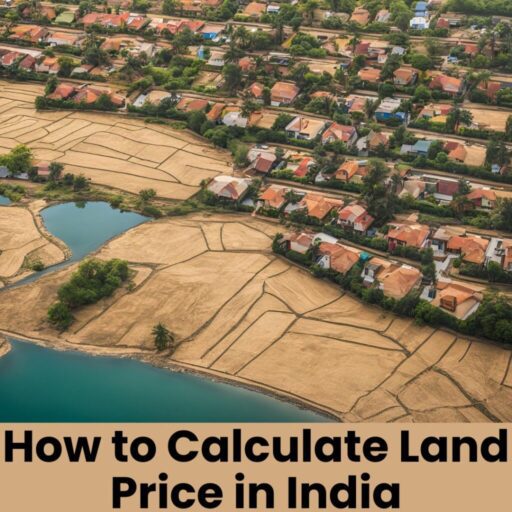Determining the price of land in India involves understanding various factors, market conditions, legal documentation, and valuation methods. Whether you’re a buyer, seller, or investor, accurate land valuation ensures you make informed decisions. In this article, we’ll guide you through the process of calculating land prices in India step by step.
Factors Influencing Land Prices in India
Several variables affect the price of land in India. Here’s an overview:
1. Location of the Land
- Urban areas, especially in metro cities like Mumbai, Delhi, and Bangalore, command higher land prices.
- Suburban and rural areas generally have lower land prices but are subject to future development potential.
2. Type of Land
- Agricultural Land: Typically costs less but comes with restrictions on usage.
- Residential Land: Cost depends on proximity to amenities, schools, hospitals, and infrastructure.
- Commercial Land: Highly valued due to its potential for businesses and investments.
3. Size of the Land
- Price per unit (square yard, square foot, or acre) is a common metric. Larger plots may cost less per unit than smaller plots, depending on location and demand.
4. Accessibility and Infrastructure
- Proximity to roads, highways, airports, and public transportation increases land value.
5. Zoning Regulations
- Zoning laws dictate the permissible use of land, influencing its price.
6. Market Trends
- Real estate trends, economic conditions, and government policies can significantly impact land prices.
7. Legal Aspects
- Clear land titles and dispute-free properties are valued higher than those with legal complications.
Steps to Calculate Land Price
1. Determine the Market Value
The market value is the estimated price at which the land would sell under current conditions.
- Sources for Market Value Information:
- Local real estate agents.
- Government websites like the state’s Department of Registration and Stamps.
- Online property valuation tools.
2. Understand the Circle Rate (Guideline Value)
The circle rate, also known as the guideline value, is the minimum price set by the government for land transactions.
- Circle rates vary by location and are available on the respective state government websites.
3. Analyze Recent Sales
Compare the sale price of similar properties in the area. This provides insights into the prevailing market trends.
4. Measure Land Area Accurately
Ensure you know the exact measurement of the land. Common units are:
- Square feet (sq ft).
- Square meters (sq m).
- Square yards (sq yd).
- Acres or hectares for larger parcels.
5. Apply the Price Per Unit Area
Multiply the area by the price per unit to get the land’s base value:
Land Price=Area (in sq ft)×Rate per sq ftLand Price=Area (in sq ft)×Rate per sq ft
6. Consider Additional Factors
Adjust the base value based on:
- Infrastructure upgrades.
- Future potential developments.
- Land shape and accessibility.
Calculation Example
Suppose you’re evaluating a 1000 sq ft plot in Bangalore.
- Market Rate: ₹5,000/sq ft.
- Circle Rate: ₹4,500/sq ft.
- Adjusted Price: ₹5,000 (higher of the two).
- Land Price: 1000×5000=₹50,00,0001000×5000=₹50,00,000.
Online Tools and Resources for Land Valuation
- MagicBricks Land Valuation Tool
Website: magicbricks.com - 99acres Property Valuation
Website: 99acres.com - State Registration Department Portals
Example: Maharashtra’s IGR Portal (igrmaharashtra.gov.in).
Legal and Documentation Aspects
1. Verify Ownership and Title
- Confirm the seller’s ownership.
- Look for clear and updated property titles.
2. Mutation Records
Mutation ensures the land records reflect the ownership transfer.
3. Encumbrance Certificate (EC)
Check for any liabilities or claims on the property.
4. Registration and Stamp Duty
Land transactions must be registered with the state government, and stamp duty varies across states.
Frequently Asked Questions (FAQs)
Q1. What is the difference between circle rate and market rate?
- Circle Rate: Government-set minimum price for land registration.
- Market Rate: Price determined by real estate trends and demand.
Q2. How do I find the circle rate for my area?
Visit your state’s official registration department website or consult the local registrar’s office.
Q3. Can agricultural land be converted to residential land?
Yes, but you’ll need to apply for land-use conversion with the local revenue department.
Q4. What documents are needed for land purchase?
- Sale deed.
- Encumbrance certificate.
- Mutation records.
- Approved layout plan (if applicable).
Q5. How do infrastructure projects affect land prices?
Infrastructure projects like new highways, metro lines, or airports increase land value by improving connectivity and development prospects.
Q6. Is online valuation accurate?
Online tools provide estimates but may lack local market nuances. Always cross-check with a real estate expert.
Q7. Are land prices negotiable?
Yes, especially in areas with lower demand. Thorough research strengthens your bargaining position.
Conclusion
Calculating land price in India involves analyzing multiple factors such as location, circle rate, and market conditions. Understanding these aspects helps buyers, sellers, and investors make informed decisions. While online tools and government resources are useful, consulting a local real estate expert ensures a more accurate evaluation.
For more information, explore trusted real estate platforms or connect with professionals in your area.
Useful Links
Chirag Singh is a content writer with a focus on real estate, covering topics like News, Guidance, Tips, Property trends and Investments. He has written for various platforms, providing helpful insights to readers. With a background in real estate, Chirag combines his knowledge and passion for real estate in his work. He enjoys staying updated on the latest industry trends.

